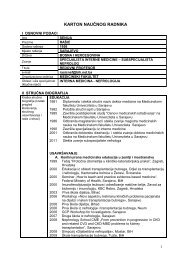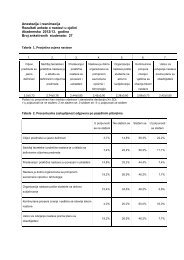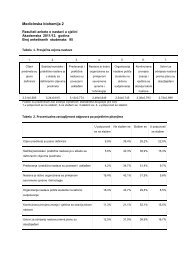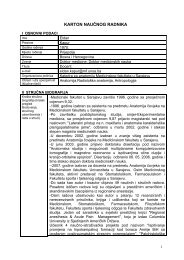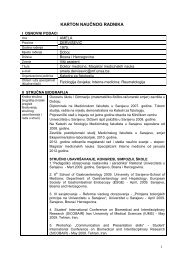Contents - Medicinski Fakultet u Sarajevu - University of Sarajevo
Contents - Medicinski Fakultet u Sarajevu - University of Sarajevo
Contents - Medicinski Fakultet u Sarajevu - University of Sarajevo
Create successful ePaper yourself
Turn your PDF publications into a flip-book with our unique Google optimized e-Paper software.
Original PapersFrequency and sex distribution <strong>of</strong> omphalocele in surgicallytreated infants in <strong>Sarajevo</strong> region <strong>of</strong> Bosnia and HerzegovinaSelma Aličelebić 1 , Amela Vilić 21, 2Institute <strong>of</strong> Histology and Embryology,<strong>University</strong> <strong>of</strong> <strong>Sarajevo</strong>, School <strong>of</strong> Medicine,Čekaluša 90, 71000 <strong>Sarajevo</strong>,Bosnia and HerzegovinaCorresponding authorSelma AličelebićInstitute <strong>of</strong> Histology and Embryology<strong>University</strong> <strong>of</strong> <strong>Sarajevo</strong>School <strong>of</strong> MedicineČekaluša 90, 71000 <strong>Sarajevo</strong>Bosnia and HerzegovinaE-mail: alicelebicselma@gmail.comOmphalocele is a prolapse (herniation) <strong>of</strong> abdominal organs,through an anterior abdominal wall defect at the base <strong>of</strong> theumbilical cord. Herniated abdominal organs (liver, small andlarge intestine, stomach, spleen, gallbladder) are covered withthe amnion and sometimes also with the peritoneum. Theaim <strong>of</strong> this research is to determine the frequency and sexdistribution <strong>of</strong> surgical cases <strong>of</strong> omphalocele treated at theClinic for Children’s Surgery; Clinical Center, <strong>University</strong> <strong>of</strong><strong>Sarajevo</strong>. It is a retrospective study that included 9 cases <strong>of</strong>surgically treated omphalocele, in the period <strong>of</strong> time from2000 until 2009. These data are obtained from the medicalprotocols and patient histories at the Clinic for the Children’sSurgery. Analysis <strong>of</strong> data found that in the period <strong>of</strong> timefrom 2000 - 2009 at the Clinic for Children’s Surgery, 9 patientswith omphalocele were treated surgically. From these9 patients, 6 <strong>of</strong> them were males (70%), and 3 females (30%).5 (55.55%) <strong>of</strong> these patients had associated anomalies, which<strong>of</strong> those the most frequent were chromosomal abnormalitiespresent at 3 patients (33.33%). Based on these data wecan conclude that omphalocele is a rare congenital anomalywhose frequency doesn’t vary a lot through the years.Key words: omphalocele, frequencyIntroductionDuring the 4 th to 5 th week <strong>of</strong> development,the flat embryonic disk folds in four directionsand/or planes: cephalic, caudal, andright and left lateral. Each fold converges atthe site <strong>of</strong> the umbilicus, thus obliteratingthe extra embryonic coela. The lateral foldsform the lateral portions <strong>of</strong> the abdominalwall and the cephalic and caudal folds makeup the epigastrium and hypogastrium (1,2). Rapid growth <strong>of</strong> the intestines and liveralso occurs at this time. During the 6 thweek <strong>of</strong> development (or eight weeks fromthe last menstrual period), the abdominalcavity temporarily becomes too small to9




